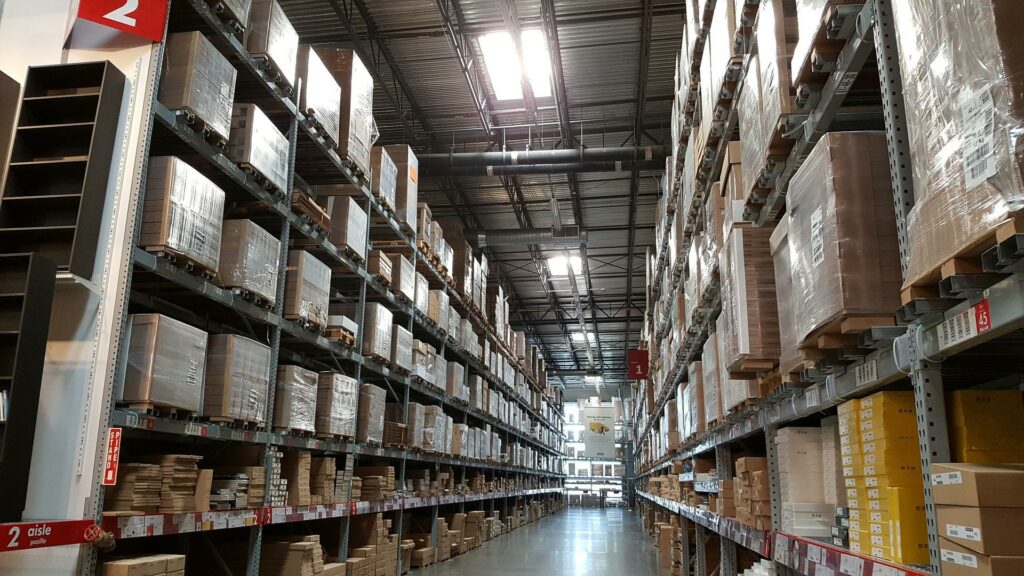Introduction
Hello there, Vocadians! This guide will tell you everything about voice picking!
Voice picking is an exciting technology on the rise. If you work with warehouses, you’re going to love that!
In this post, we’ll talk about:
- What a voice picking system is and how you could use them;
- The benefits and applications of voice picking;
- Whether or not voice picking is suitable for your warehouse.
Let’s begin!
What is a voice picking system?
Okay, let’s picture this: imagine you’re working at a big warehouse where lots of products of different nature are placed in specific locations.


One day, you get instructed to pick up a product from a particular slot in the warehouse. You check your task information and your other documents to find the right product.
Once you’re done with the paperwork and got the location of the article, you go there reach the rack and finally put your hands on the desired item
After handing the box over to the shipment department, you check the next order on the system and you start the whole process all over again.
At the end of the day, tired of your hard labour, you sit down to think about how to make this job more efficient. In particular, you notice that all the paperwork takes a lot of time and is really error-prone.
Moreover, without a proper warehouse management plan, the overload of employees considerably increases the risk of accidents.


In these kinds of industries, voice picking plays an essential role as it greatly simplifies management at all levels.
Voice picking is a hands-free and eye-free system that uses an intelligent voice assistant and speech recognition technology to guide associates through their tasks.
The phrase “voice picking” refers to a method of improving picking operations using voice-only technologies. However, today’s voice-directed applications often incorporate complementary technologies like barcode scanning or RFID.
Voice-picking systems work hand in hand with a WMS (Warehouse Management System) or ERP (Enterprise Resource Planning) system running on-premises or in the cloud. Pickers are required to wear headsets with industrial microphones and carry a mobile device running the voice picking application.


When a warehouse worker gets instructions to pick up a certain product, they hear all the relevant information in their headset and can communicate back with the system by talking to it.
The central WMS is constantly updated to accurately reflect the status of the facility. Voice picking helps simplify one of the most crucial processes of warehouse management; product picking.
What are the benefits of voice picking?
Voice picking has the potential to simplify most processes in a warehouse and establish an efficient management plan where each worker can perform any task without miscommunications and unnecessary mistakes.
Let’s have a look at the benefits of voice picking.
- Boost speed and accuracy of orders: Since voice is hands-free, the warehouse pickers can focus on quickly locating their products rather than handling multiple items at once, and end up being lost. Higher accuracy means happier customers as the orders are delivered quicker thanks to efficient warehouse management.
- Increased productivity: Since voice helps handle the crucial procedures, users are less likely to get stressed due to management, thus increasing productivity and enhancing work output.
- With the help of voice, the worker’s hands are not filled with files as the interaction with the WMS is done completely via voice
- Accurate inventory counts: Inventory counts improve with better picking accuracy. Warehouses often organize their items in ways that simplify the picking experience. When combined with voice picking technology, a company can manage inventory more accurately thanks to a high degree of organization.


- Picking errors are reduced: By avoiding distractions such as scanners and papers, the chance of being distracted at the picking area is reduced. Due to workers’ verbal confirmations of each pick, order accuracy rates are higher.
- Studies have shown that picking errors on average range from 1 to 3% – or between 10 and 30 per 1,000 picks. With a real-time Distribution System (RDS) voice technology and integrated barcode scanning validation, accuracy can be increased to 99.99%, or only one error every 1,000 picks.
- Accurate information is vital for the bottom line since errors can cost between $50 and $300 each.
- Shortened training time: Voice picking is easy to learn for warehouse workers so it takes less time for them to be operational. Following simple voice commands is easy, making it easy for workers to accommodate the technology! Since there is less training, work and outcome efficiency is increased.
- Warehouse safety: Pickers often have to use box cutters or lift heavy objects, so they must be able to use their hands. This is where voice picking comes in handy.
- Happier employees: Vocal technology is easy to use, and it makes workers more efficient, so they feel more productive. It also requires very little training, so they can make an immediate contribution.
How to use voice picking?
Using voice picking is as simple as listening to music: just wearing a headset and responding to verbal instructions by speaking or scanning.
Let me explain:
- As part of their picking duties, warehouse workers receive voice-picking devices, special-purpose mobile computers connected to headsets with microphones and barcode scanners.
- The WMS or ERP system collects Aggregates all customer order details and efficiently dispatches them to pickers.
- The voice-picking device gives instructions to the warehouse worker, communicating the picking tasks and their locations.
- The worker then confirms the job information by voice: no more manual text entry!
- When the worker arrives at a specific location, they verbally provide the confirmation digits to verify the location.
- The voice-picking system then prompts to confirm the aisle or section and provides the operator with the pick quantity. The operator verbally confirms the quantity.
- When the task is completed, the system sends the picker to the next pick location, providing an optimal path to maximize the worker’s efficiency.
- All interactions between the picker and the voice application are tracked, so managers can view the progress of orders live as they are being fulfilled.
To learn about voice picking more visually, watch this video explaining how voice picking works. Thanks to Honeywell for this amazing resource!
Applications of voice picking
Voice picking helps in many aspects and processes in the warehouse such as picking up orders, hands-free formalities, processing all paperwork, and more!
Let’s find out where voice picking is applied in today’s world!
Cross Docking
Cross-docking is a practice in logistics of unloading materials from a manufacturer or mode of transportation directly to the customer or another mode of transportation, with little or no storage in between.
Voice picking can support various cross-dock processes, including full transfers from receiving to shipping, or moving and sorting to outbound staging destinations.


Piece Picking
Piece picking is the process of picking the individual items of order and placing them in a container or carton before shipping them to the customer. Order picking is a labour-intensive process that accounts for up to 55% of warehouse or distribution centre operating costs.
Piece picking by voice can simplify many different workflows, including piece picking to totes or cartons on carts, or conveyors in a pick module. These include bucket-brigade pick and pass systems (zoneless picking), pick-and-put for high volume items, and two-stage picking for slow-moving items.
Putaway
Putaway refers to all the warehouse tasks that happen between receiving products from a vendor and having them stored away on racks and shelves in your warehouse.
With voice-directed putaway, you can store complete pallets, mixed pallets (multiple SKUs stored in separate locations), or carts with mixed SKUs. As part of the voice-directed workflow, barcode scanning is commonly used to identify/verify putaway items.


Receiving and returning
Receiving and returning is one of the most common and vital processes of warehouse operations as it’s one of the most basic duties.
When receiving pallets with mixed or full contents, voice can be used to identify damages, verify quantities, and sort and stage items to be put away. A barcode scanner and visual displays can be incorporated into the process.
Inventory management
Field inventory management, more commonly known as inventory management, is an analysis of an organization’s stock mix and the different demands on that stock.
This is a vital process of warehouse management as it helps provide information on how much stock is present in the warehouse, which ones would be shipped off and what products have been returned.
A voice-picking system provides a high degree of order accuracy, resulting in accurate inventory counts.
Like this, there are many different aspects of warehouse management where voice can help simplify most processes and help improve work performance for all warehouse workers.
Is voice the right choice for my warehouse?
Voice-directed applications are most commonly used in warehouses and distribution centres shipping products in case quantities or fewer.


Many warehouses that only receive and ship full pallets use voice, although voice, compared to other technologies (RF, or barcode scanning), the same voice technology would be seen as both a benefit or an unnecessary addition depending on a number of factors.
Here are some factors to consider to determine if the voice is a good fit for your operation:
Industry: The use of voice is widespread today in warehouses and distribution centres in outbound product distribution, direct-to-consumer e-commerce fulfilment, as well as parts, picking and kitting operations.
With voice, virtually any product type can be packed and shipped, including clothing, nuts, bolts, and wire coils (for example). Voice is used by a variety of industries today, including, but not limited to:
- Retail and eCommerce Fulfillment Centers
- Beverage Wholesalers: Beer, Wine & Spirits, Soft Drinks
- Grocery and Food Distribution: Fresh, Frozen and Packaged Food
- Foodservice and Convenience
- Healthcare Products and Pharmaceuticals
- Manufacturing
- Industrial, Parts, HVAC and Electrical Supply
Facility Size: Warehouses and distribution centres ranging from 50,000 ft² to 1 million ft² or larger are great candidates for voice.
Number of SKUs: The minimum number of SKUs is between 300 and 500. The maximum number of parts can be as high as 1 million in some manufacturing facilities that use voice.
Some Selectors/Pickers and Other Voice Users: Most DCs using voice have at least 10 concurrent pickers per shift. There is no upper limit to the number of users in a single facility.
Companies that provide voice picking technology
With the advent of voice technology, many companies are still trying to adopt it as voice helps in simplifying any task that requires both physical and mental strain.
Likewise, working in a warehouse brings in lots of mental and physical strain as workers would have to handle both the paperwork of each item and article stored in the warehouse, but also take proper care and storage of articles in the warehouse. Voice helps in simplifying the processes and making everyone’s life easier.
Today’s main voice picking technology providers are:
- Honeywell
- Korber (Then Voiteq)
- Lydia Voice
- Zetes
- Keen Research
- And more!
Conclusion
And there you have it! We have completed our blog on voice picking!
Voice picking helps simplify one of the most important processes of e-commerce, warehouse and inventory management. As such, itit helps customers get the right products as fast as possible!
Let us know if you have any thoughts regarding voice picking by commenting down below!
Also, don’t forget to share it on your social media platforms!


